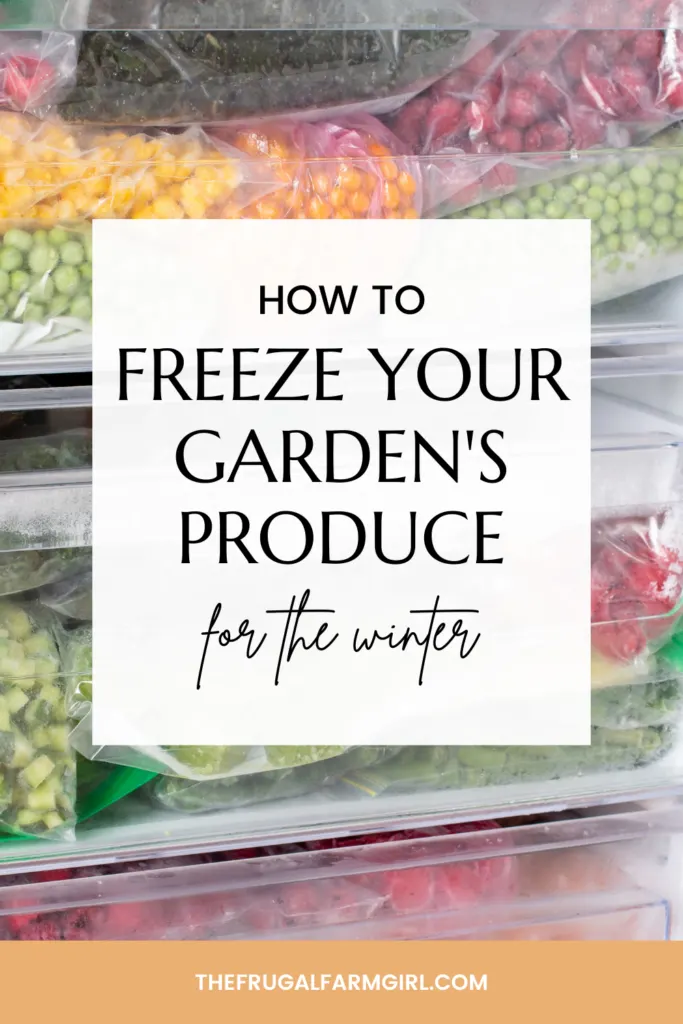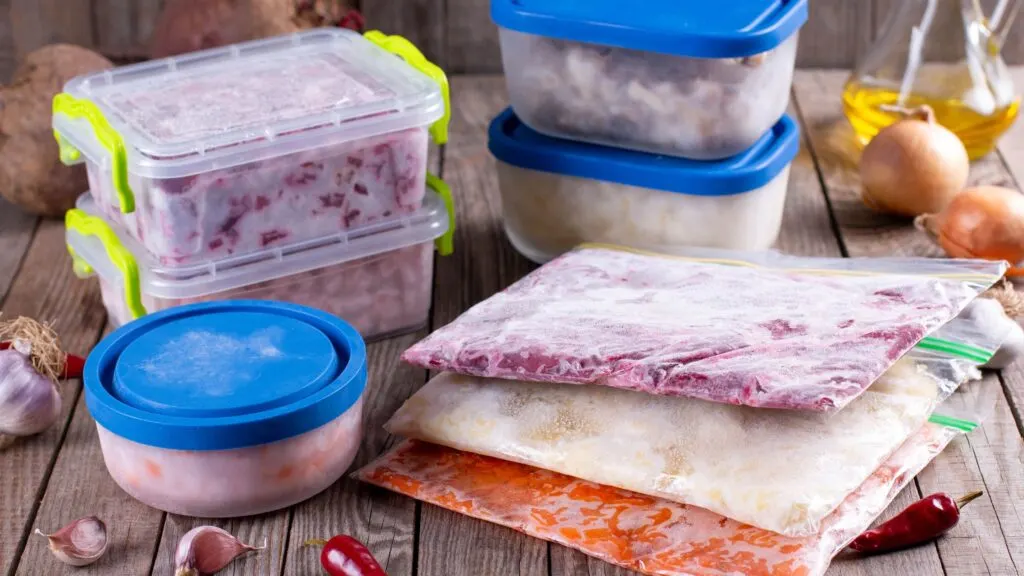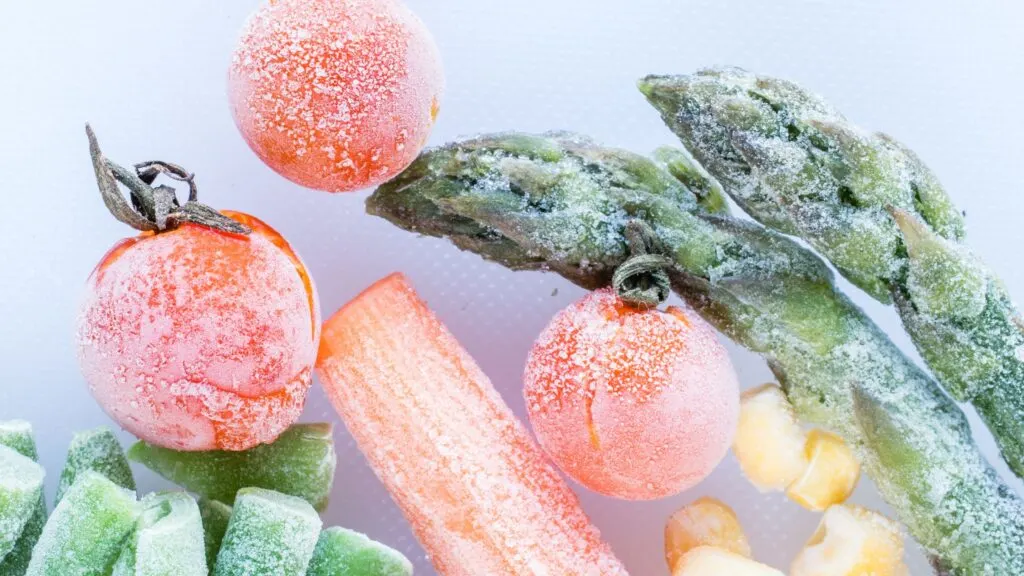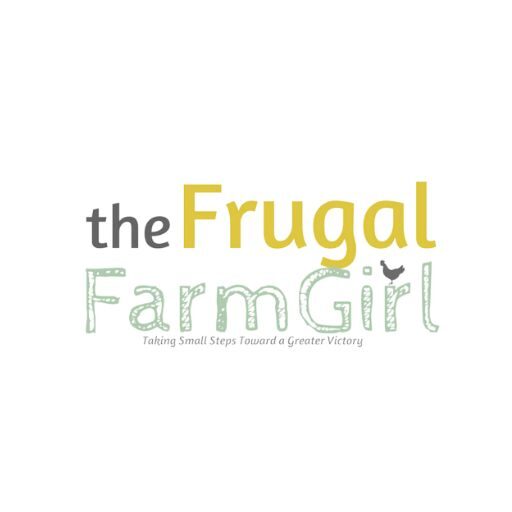If you’re like me, you want to take advantage of summer’s bounty by preserving some fresh fruits and veggies for later in the year. And if you’re like me, you also want to do it as cheaply and efficiently as possible.
So today, I’m going to share my simple tips for freezing fresh produce. Let’s get started!
A surprisingly large variety of fruits and veggies can be frozen as is, or you can wash and chop them into a form that is easy to pull out and cook down the road.
This won’t take long and will make cooking much easier when it is time to use these yummy foods. Cutting fruits and vegetables also allow you to pack them in tighter, giving you more space in the freezer.

Start with Fresh Produce
Start with high-quality produce. If the produce is bruised or otherwise damaged will not taste good once been frozen. Therefore, it’s best to start with fresh, high-quality produce if you want the end result to be delicious.
Wash everything thoroughly. Dirt and debris can ruin delicious good produce, so give everything a good wash before freezing it. Cut up larger pieces of fruit and vegetables.
This will make them easier to thaw and use later on. Plus, smaller pieces take up less space in your freezer.
Blanching is not necessary for most fruit. However, some vegetables (such as green beans) benefit from being blanched being frozen. This process helps preserve their color, texture, and flavor.
Be sure to label everything! Write the name of the produce and the date on each container or bag before putting it in the freezer. This will save you a lot of time when you can’t remember what’s in each container.
Freezing produce isn’t the only method to preserve your foods; check out the other options here.

Vegetables that Don’t Freeze Well
Carrots, celery, and potatoes are among the vegetables that shouldn’t be frozen because they tend to turn mushy when thawed.
If you absolutely must freeze them, cook them first so that they retain their texture and flavor better during the freezing process.

There are a few foods that don’t freeze well, including:
– cucumbers
– lettuce
– radishes
– potatoes (whole)
– watermelon
– cantaloupe
– honeydew melon
– oranges
– grapefruit
– lemons
– limes
– pineapple
– tomatoes

Fruits That Freeze Well
Let’s run through a couple of things you may choose to freeze. Berries are one of the easiest fruits to freeze and are best frozen.
Keep them in the freezer, then pour them out as needed to top oatmeal, make smoothies, or bake a pie. For example, other fruits like peaches, bananas, and pineapple freeze well, but peeling and chop them first is much easier.
Apples and pears don’t freeze well unless you first turn them into pie filling. Grapes can be frzen, but donít thaw well. But, if your kids haven’t tried frozen grapes, it’s like sweet candy. My girls loved frozen grapes as toddlers.
One of my favorite cheap snacks to make is a frozen smoothie!
Most fruits freeze well, but some of the best include:
– berries
– cherries
– peaches
– nectarines
– apricots
– plums
– pears
– apples
– bananas (sliced)
-grapes

Veggies That Freeze Well
Lots of veggies can also be rinsed, chopped, and frozen. Green beans, peas, squash, broccoli, corn, and cauliflower freeze very well.
Some of the best vegetables to freeze include:
– peas
– corn
– green beans
– broccoli
– cauliflower
– carrots
– Brussels sprouts
– spinach
The frozen food section at the grocery store is a great place to find produce that will freeze well. Just rinse the produce as it comes out of the garden or from the farmer’s market, chop it, and put it in freezer bags.
You can even freeze potatoes if you peel and grate them first. Likewise, peppers and onions do well chopped and frozen.
This method is a great way to extend your produce’s life and ensure that you always have fresh produce on hand. Plus, it’s a great way to save money on your grocery bill. If you don’t have a ton of space to start a garden, consider container gardening.
So next time you’re at the store, check out the frozen food section for all your produce needs.

Don’t forget to label everything really well
When frozen produce, it’s important to label everything well. Include the name of the fruit or vegetable and the date you put it in the freezer. This will help you track what you have and how long it will last.
Use The Right Containers
For most fruits and vegetables, any airtight container will do. However, there are a few things to remember when choosing containers. First, if you’ll be freezing liquids, like soup or pureed fruits, make sure the container is leak-proof.
And if you’re freezing something that expands when frozen, like bread dough, leave some headspace in the container to allow for expansion.

Should You Freeze Tomatoes?
Tomatoes can be tricky if you don’t have the time to do anything with them immediately; chop and freeze them and then use them in green smoothies to make salsa or pasta sauce and tomato soup down the road.
If you have extra time on your hands, I find you get much better results cooking the sauce or soup now and then freezing it.
One of the great things about frozen tomato soup is that it’s so easy to make a meal. Just grab a container of the soup from the freezer, slowly heat it up on the stove, and make a couple of grilled cheese sandwiches while it’s warming. And voila – dinner is made!
The soup is usually pretty hearty, but the grilled cheese sandwiches add comfort food.
Plus, they’re an excellent way to use up any leftover bread you might have. Finally, if you’re ambitious, you could try adding some chopped-up vegetables to the soup.
But however you make it, frozen tomato soup is a quick and easy meal that will leave you feeling satisfied.

Freezing Herbs
If you’ve ever grown your herbs, you know how quickly they can become overloaded. Herbs are generally best used fresh, but if you find yourself with a surplus, don’t despair! Frozen herbs can be a great way to preserve them for later use.
The key is to take care when freezing them to retain as much flavor and color as possible. First, wash the herbs and pat them dry. Then, depending on the herb type, you can chop them or leave them whole.
Next, spread the herbs on a baking sheet and place them in the freezer. Once they’re frozen solid, transfer them to an airtight container or zip-top bag.
Freezing herbs can also be done in ice cube trays. Simply chop up the herbs and place them in the tray, then add water or olive oil and freeze. Once they’re frozen, transfer them to a freezer bag. This is a great way to have fresh herbs on hand all winter long!
Label the bag with the date and type of herb, then pop it back in the freezer. Frozen herbs will keep for up to six months.
When you’re ready to use them, remove the amount you need and let it thaw at room temperature before using it in your favorite recipe.

Freezer Meals
One best way to use leftover produce is to make freezer meals. This can be a great way to batch cook for quick and easy dinners. Soups, stews, pies, and casseroles are all great options when you have leftover produce.
They can be easily reheated and don’t require a lot of effort to make. In addition, they’re a great way to use up any produce starting to spoil.
Next time you have some extra produce, don’t let it go to waste. Instead, make some freezer meals and enjoy them for quick and easy dinners.
So, what are you waiting for? Get started preserving your food and enjoy it all winter long! These tips are simple and easy to follow, so you can freeze your fresh produce like a pro.
What’s your favorite way to preserve fresh produce? Let us know in the comments below.
